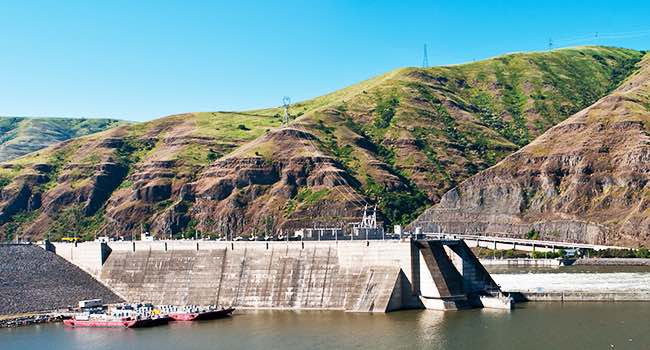forum
library
tutorial
contact

Army Corps Attempts to
Engineer Salmon Recovery
by Brett Wedeking
The Drake, June 8, 2016
|
the film forum library tutorial contact |

|
Army Corps Attempts to
by Brett Wedeking
|
Rules keep individuals small, aggregations above 0.5 MW
 Summer 2015 left Snake River salmon and steelhead hankering for relief. The thermal barrier created by the four lower Snake River dams contributed to soupy water temps nearing 70 degrees. And thousands of federally threatened and endangered returning adults and out-migrating juveniles met their demise.
Summer 2015 left Snake River salmon and steelhead hankering for relief. The thermal barrier created by the four lower Snake River dams contributed to soupy water temps nearing 70 degrees. And thousands of federally threatened and endangered returning adults and out-migrating juveniles met their demise.
To combat lethal temps and prevent future mortality, the dam-managing US Army Corps of Engineers has surfaced with a few band-aids. A new fish ladder cooling system was completed this winter at Lower Granite Dam, drawing cold water from deep in the river to flush into the ladder. The Juvenile Bypass System is also sporting an upgraded flume that is expected to ease the journey for fragile salmon and steelhead smolts through Lower Granite.
While the Army Corps attempts to re-engineer nature, conservation groups and anglers continue their call for real, wrecking-ball solutions.
"While it's important we meet the near-term needs of the Snake River's endangered wild fish with actions that address, in this case, thermal barriers, their long-term future depends on removing these four costly dams," says Save Our Wild Salmon Executive Director Joseph Bogaard. "[Salmon and steelhead] survival requires a healthy, resilient, freely-flowing river and fully restored access to the millions of acres of pristine, high-elevation habitat upstream from the lower Snake in central Idaho and eastern Oregon and Washington."
Meanwhile in May, to the delight of river advocates, U.S. District Judge Michael H. Simon rejected the current federal Columbia/Snake River salmon recovery plan--that does not contain dam removal as an option--as a failed effort and mandated a new plan be drafted by March 2018.
learn more on topics covered in the film
see the video
read the script
learn the songs
discussion forum
